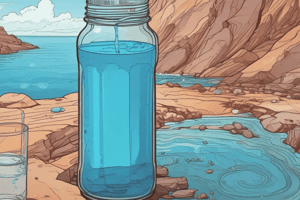Podcast
Questions and Answers
Which of the following is primarily responsible for the diffusion of water in osmosis?
Which of the following is primarily responsible for the diffusion of water in osmosis?
- Concentration differences of dissolved substances (correct)
- Nutrients
- Oxygen
- Temperature regulation
Water helps in temperature regulation in the body.
Water helps in temperature regulation in the body.
True (A)
What is the role of hormones in water regulation?
What is the role of hormones in water regulation?
Hormones such as antidiuretic hormone (ADH) help regulate water balance by affecting kidney function and water retention.
The _______ are primarily responsible for regulating hydration levels in the body through filtering blood and forming urine.
The _______ are primarily responsible for regulating hydration levels in the body through filtering blood and forming urine.
Match the following effects with their corresponding state:
Match the following effects with their corresponding state:
What can result from a deficiency of water in the body?
What can result from a deficiency of water in the body?
Body water is distributed evenly throughout all body compartments.
Body water is distributed evenly throughout all body compartments.
Explain how osmosis affects water distribution in the body.
Explain how osmosis affects water distribution in the body.
What primarily determines the movement of water inside and outside of cells?
What primarily determines the movement of water inside and outside of cells?
The kidneys only filter blood and do not reabsorb any necessary substances.
The kidneys only filter blood and do not reabsorb any necessary substances.
What can activate the thirst center in the brain?
What can activate the thirst center in the brain?
The hormone responsible for increasing water reabsorption in the kidneys is called ______.
The hormone responsible for increasing water reabsorption in the kidneys is called ______.
Match the following conditions with their potential symptoms:
Match the following conditions with their potential symptoms:
Which of the following is NOT a hormone that regulates water balance?
Which of the following is NOT a hormone that regulates water balance?
Increased sodium concentration in the blood can lead to dehydration.
Increased sodium concentration in the blood can lead to dehydration.
What factors can influence the amount of water loss from the body?
What factors can influence the amount of water loss from the body?
The process of water moving from areas of low solute concentration to high solute concentration is known as ______.
The process of water moving from areas of low solute concentration to high solute concentration is known as ______.
Which of the following symptoms is associated with severe dehydration?
Which of the following symptoms is associated with severe dehydration?
What is hyponatremia primarily caused by?
What is hyponatremia primarily caused by?
Men aged 19-30 years require 2.6L of water per day.
Men aged 19-30 years require 2.6L of water per day.
What role does the parathyroid hormone (PTH) play in calcium regulation?
What role does the parathyroid hormone (PTH) play in calcium regulation?
Excess sodium from consumption may lead to __________ imbalance.
Excess sodium from consumption may lead to __________ imbalance.
Match the following electrolytes with their primary locations:
Match the following electrolytes with their primary locations:
What might be an indicator of fluid retention?
What might be an indicator of fluid retention?
Iron deficiency anemia is characterized by an excess of red blood cells.
Iron deficiency anemia is characterized by an excess of red blood cells.
What are the consequences of electrolyte deficiency?
What are the consequences of electrolyte deficiency?
Calcium in the body is primarily stored in __________ and __________.
Calcium in the body is primarily stored in __________ and __________.
Which of the following enhances the absorption of non-heme iron?
Which of the following enhances the absorption of non-heme iron?
Water consumption needs are influenced solely by gender.
Water consumption needs are influenced solely by gender.
What can excessive potassium intake from supplements cause?
What can excessive potassium intake from supplements cause?
Sodium is an __________ ion primarily found outside the cell.
Sodium is an __________ ion primarily found outside the cell.
What are the recommended daily calcium needs for adults aged 19-70?
What are the recommended daily calcium needs for adults aged 19-70?
Using an iron pan doesn't affect iron absorption from food.
Using an iron pan doesn't affect iron absorption from food.
Flashcards
Water Balance
Water Balance
Maintaining equal water intake and output in the body to keep hydration levels stable.
Electrolytes
Electrolytes
Substances that regulate water distribution inside and outside cells, impacting bodily functions.
Dehydration
Dehydration
A state where the body loses more water than it takes in, potentially leading to symptoms.
Thirst
Thirst
Signup and view all the flashcards
Kidneys
Kidneys
Signup and view all the flashcards
Antidiuretic Hormone (ADH)
Antidiuretic Hormone (ADH)
Signup and view all the flashcards
Blood Pressure
Blood Pressure
Signup and view all the flashcards
Water Intake
Water Intake
Signup and view all the flashcards
Water Output
Water Output
Signup and view all the flashcards
Water Loss
Water Loss
Signup and view all the flashcards
Major minerals
Major minerals
Signup and view all the flashcards
Water's role in transportation
Water's role in transportation
Signup and view all the flashcards
Osmosis in water balance
Osmosis in water balance
Signup and view all the flashcards
Intracellular water
Intracellular water
Signup and view all the flashcards
Extracellular water
Extracellular water
Signup and view all the flashcards
Water's function in chemical reactions
Water's function in chemical reactions
Signup and view all the flashcards
Water's role in body temperature
Water's role in body temperature
Signup and view all the flashcards
Water's role in blood volume
Water's role in blood volume
Signup and view all the flashcards
Hyponatremia
Hyponatremia
Signup and view all the flashcards
Fluid Accumulation
Fluid Accumulation
Signup and view all the flashcards
Electrolyte Imbalance
Electrolyte Imbalance
Signup and view all the flashcards
Bone Remodeling
Bone Remodeling
Signup and view all the flashcards
Peak Bone Mass
Peak Bone Mass
Signup and view all the flashcards
Osteoporosis
Osteoporosis
Signup and view all the flashcards
Calcium Homeostasis
Calcium Homeostasis
Signup and view all the flashcards
Parathyroid Hormone (PTH)
Parathyroid Hormone (PTH)
Signup and view all the flashcards
Calcitonin
Calcitonin
Signup and view all the flashcards
Hemoglobin
Hemoglobin
Signup and view all the flashcards
Myoglobin
Myoglobin
Signup and view all the flashcards
Iron Deficiency Anemia
Iron Deficiency Anemia
Signup and view all the flashcards
Iron Recycling
Iron Recycling
Signup and view all the flashcards
Heme Iron
Heme Iron
Signup and view all the flashcards
Study Notes
Water and Minerals Unit 10
-
This unit covers nutritive values, functions, food sources, dietary requirements, absorption, deficiency consequences, water & electrolytes, and maintaining fluid balance of water and minerals.
-
The structure includes lecture content about an overview of minerals, calcium, iron, water and electrolyte balance, and independent study for review of specific tables. These tables detail other minerals; memorization of them is not required.
-
Micronutrients are nutrients needed in small amounts.
-
Minerals are elements needed to maintain structures and regulate chemical reactions & body processes.
-
Major minerals are required in the diet in amounts greater than 100mg/day, and are greater than 0.01% of body weight.
-
Minor minerals are required in the diet in amounts less than or equal to 100mg/day, and are less than or equal to 0.01% of body weight.
-
Electrolytes include sodium, potassium, and chloride. They are charged ions that conduct electrical current in the body, impacting electrical activity & fluid balance.
-
Major minerals include calcium, phosphorus, magnesium, and sulphur, which are important for bone health, acid-base balance, ATP production, and amino acid components.
-
Trace minerals include iron, copper, zinc, selenium, iodine, chromium, fluoride, manganese, molybdenum, and other trace minerals. These are critical for hemoglobin, protein synthesis, immunity, antioxidants, hormones, tooth enamel, and metabolic enzymes.
-
Mineral functions include contributing to body structures, regulating body processes, water balance, and energy metabolism.
-
Minerlas influence growth, development, and act as cofactors for enzyme activity.
Mineral Functions in the Body
- Food sources of minerals vary depending on the type of mineral.
- Sodium, potassium, and chloride regulate fluid balance.
- Iron, copper, calcium, zinc, selenium, and magnesium are crucial for blood health and a robust immune system.
- Calcium, phosphorus, magnesium, and fluoride are vital for healthy bones and teeth.
Mineral Absorption
- Mineral absorption depends on factors such as the person's nutritional status, food consumed concurrently, and the nutrient's structure.
- Bioavailability is the extent to which the body can absorb and use a nutrient—animal sources are often better absorbed.
- Phytates, oxalates, and fiber in plant foods can hinder mineral absorption, as seen with minerals like calcium, iron, zinc, and magnesium.
Minerals in Foods
- Various foods contain specific minerals.
- Vegetables and fruits, grains, milk, and meat/alternatives all offer different minerals.
- Charts of what types of minerals are present and in what portions of various foods.
Water & Electrolytes
- Water comprises 2/3 of intracellular fluid (within cells) and 1/3 of extracellular fluid (outside cells).
- Extracellular fluid includes blood, lymph, and digestive juices.
- Water is also interstitial (between cells).
- Water is vital for nutrient transport, chemical reactions, solvent, acid-base balance, lubricant/cushions around joints, shock absorption, temperature regulation, blood volume & blood pressure, and fecal matter softening.
Electrolyte Balance
- Sodium, potassium, and chloride are key electrolytes.
- Deficiencies in these can cause acid-base imbalance, poor appetite, muscle cramps, constipation, irregular heartbeats, and potentially death.
- Excess electrolytes can negatively impact the heart's function and cause acid-base imbalance
Bones
- Bones are primarily composed of protein matrix (mostly collagen)—a living tissue, hardened with minerals.
- Key minerals include calcium, phosphorus, magnesium, sodium, and fluoride.
- Essential for growth, movement, maintaining bone density and participating in bone remodeling. Peak bone mass is usually achieved in young adulthood.
Calcium
- Calcium is the most abundant nutrient in the body, most stored in bones and teeth.
- Essential functions include muscle contraction, blood clotting, nerve impulse transmission, acid-base balance, hormone secretion, regulation of enzymes, and maintaining blood pressure.
- Calcium regulation involves hormones like parathyroid hormone (PTH) and calcitonin (from the thyroid).
Calcium Needs
- Calcium needs differ depending on age and gender, particularly after menopause.
Iron
- Iron is crucial for blood (red blood cells and hemoglobin), myoglobin in muscles, ATP production, DNA synthesis, and immune function.
- Iron losses occur through cell loss, blood loss, injury, trauma, blood donations, and menstrual loss.
- Iron recycling involves the liver & bone marrow to reuse old iron from breaking down red blood cells. The cycle is involved in the reuse of iron to create new hemoglobin.
- Bioavailability of iron from various sources (animal vs. plant) differs substantially due partially to differing absorption rates
Iron Deficiency
- Insufficient iron levels can lead to iron deficiency Anemia, characterized by insufficient hemoglobin in red blood cells, leading to fatigue, weakness, pale skin, shortness of breath, and abnormal heart rate.
Iron Supplements
- Iron supplements are sometimes necessary for treating Iron deficiency anemia though bioavailability differs and absorption can be problematic. Iron supplements can have unintended side effects (absorption issues and/or intestinal upsets).
Water Balance
- To maintain water balance, intake must equal output.
- Intake includes consuming water, fluids, foods, and cellular respiration.
- Output involves excreting water through urine, feces, sweat, and evaporation from skin and lungs.
- Water loss depends on activity, temperature, and humidity.
- Dehydration happens when water intake falls below expenditure.
- Thirst is a signal to increase water intake.
- Kidneys regulate this balance,
- Hormones (ADH, angiotensin II, aldosterone) work with kidneys to control water reabsorption, influence thirst, and maintain electrolyte balance to maintain overall hydration.
Risk of Dehydration
- Mild symptoms of dehydration include thirst, dry lips and mouth, tiredness, dark smelling urine, headaches, dizziness, fainting, low blood pressure, increased heart rate, and irritability.
- Severe dehydration can lead to cold hands and feet, rapid breathing, unconsciousness, blue lips and blotchy/dry skin, and lack of energy
Overhydration
- Water intoxication is rare but possible, especially from overconsumption of water due to a disorder in the body's ability to excrete water or when there is electrolyte unbalance (e.g., hyponatremia).
- Symptoms include abnormal fluid accumulation in body tissues like swelling, potentially leading to death.
Water Intake Recommendations
- Water recommendations vary based on age, activity levels, and illnesses
Bottled Water vs Tap Water
- Differences include labels of bottled water sources (which potentially come from tap water) and costs (including environmental impacts associated with bottled water vs. tap water)
DRI for Iron and Dietary Sources
- Dietary Recommendations for iron, and information and specific examples that illustrate the impact of factors such as age group and intake on absorption rates of iron.
Studying That Suits You
Use AI to generate personalized quizzes and flashcards to suit your learning preferences.




